Nixeus VUE 30: 30" 2560x1600 IPS Monitor Review
by Chris Heinonen on August 20, 2013 6:00 AM ESTLarge panels seem to do better with our advanced uniformity testing, and the Nixeus does quite well overall here. There is an issue with some lack of light at the very top of the display, but overall most of the display is very even and uniform when compared to the center. White Uniformity is very good overall. That top row causes some issues, but the rest of the screen is very good. There isn’t anything bad to say about it aside from the very top and I didn’t notice that in daily work.
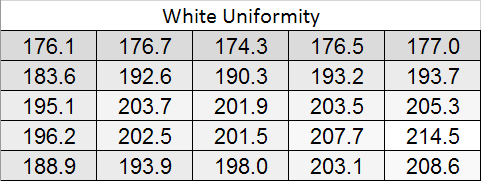

Black Uniformity is very similar. It has a drop in black level at the top, just like white does, but the rest of the screen is pretty accurate when compared to the center calibration target.
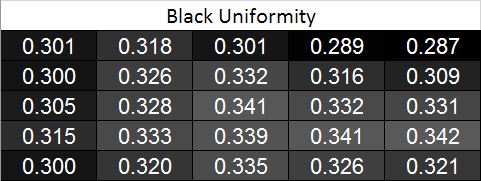
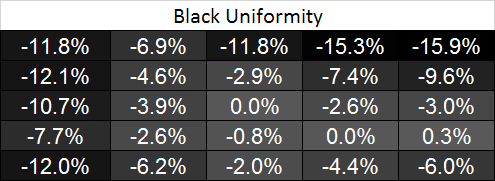
Since both White and Black have issues in the same screen areas, we wind up with a very uniform screen for our contrast ratio. It does dip down a little bit at a couple edges and corners, but most of the screen is +/- 5% when compared to center.
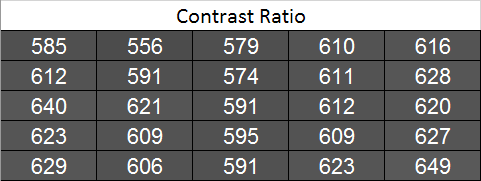

Our dE2000 errors compared to center are very good except for that top row. The lighting issue there causes a high level of error when compared to the rest of the screen, though the errors barely creep up into the visible level at the worst areas. The center of the screen is very good and would work really well for photo editing and other tasks. This makes the lack of a good sRGB mode even worse, as the good uniformity of the display would make it a nice choice for doing color critical work, but the poor gamut results make that a less likely use for it (though of course professional apps are the most likely to support the AdobeRGB color space).
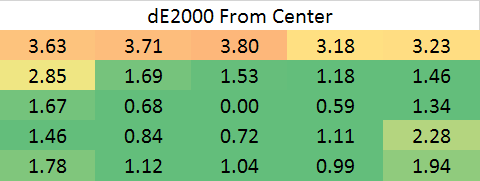
For everyone else, the display itself is very uniform except for a slightly darker area at the top. The bottom-right corner measured slightly hot, but the light bleed there was only noticeable on a pure-black screen if I was really looking for it. Otherwise the amount of light leakage is so low as to not cause a problem.










95 Comments
View All Comments
cheinonen - Tuesday, August 20, 2013 - link
I'm finishing up a review of a 27" Monoprice display now that should run next week.blackoctagon - Thursday, August 22, 2013 - link
What about the overclockable 27-inch IPS screens, Chris? They can be sourced locally (from US) these days so no need to acquire one from Korea anymore. God knows there's been enough obsession about them during the past 12-18 months...and yet we still don't have truly professional reviews of themrepoman27 - Tuesday, August 20, 2013 - link
Can we please stop the silly trend of referring to all displays as [vertical resolution] & "p"? The resolutions and aspect ratios of computer displays are not governed by the ATSC or DVB, and none of these panels are intended to be driven in an interlaced mode. At best the "p" just sits there conveying no useful information, at worst it causes the writer to omit actually useful information.[horizontal resolution] & "x" & [vertical resolution] is better, and likely preferable to the rather forgettable initialisms such as "WQXGA". If you are talking about a display with an ATSC or DVB defined resolution and want to use the "p" nomenclature, at least include the maximum refresh rate, since this will definitely be a concern with the initial wave of UHDTV panels.
blackoctagon - Tuesday, August 20, 2013 - link
You're right of course, but typing 1440p is a lot quicker than 2560X1440. Not to mention the fact that pretty much everyone knows (or should know) what 1080p/1440p/1600p is shorthand for in the context of computer monitors.piroroadkill - Tuesday, August 20, 2013 - link
I agree.The p is totally hopeless information. Pointless trend. Even worse, when people have described 1920x1200 tablets as "1080p" or "Full HD". I don't want a 1920x1080 screen necessarily, but a 1920x1200 one is a more compelling ratio.
Impulses - Tuesday, August 20, 2013 - link
Alluding to the new Nexus 7 there? I had a chuckle when I saw Google use both terms on the official Play store page, right alongside the 1920x1200 listed res. It's like the average consumer can't even be counted on to remember more than one number anymore or even assume larger = better (probably why 4K has emerged as a label, anything more technically accurate would just go in one ear and out the other).DanNeely - Wednesday, August 21, 2013 - link
4k emerged as a term years ago in high end professional video circles because all but one of the resolutions used were 4096 pixels across; the aspect ratio was varied solely by changing the vertical resolution. From there it just trickled down; we geeks read about it on gadget blogs/etc and lusted after stuff that would support it while costing less than our homes and gradually popularized it as the next big thing. Meanwhile, and unsurprisingly the TV people settled on the slightly smaller quadHD standard since it has less implementation/back compatability issues.blackoctagon - Thursday, August 22, 2013 - link
I think you're being overly fussy. Even John Carmack casually uses the 'p' when describing the resolution of non-TV displays (just heard him do so on the QuakeCon keynote)7beauties - Tuesday, August 20, 2013 - link
Since this is an IPS panel, it probably goes without saying that its refresh rate is just 60Hz. The response time of 7ms is borderline if you're a gamer. What's most disappointing to me is that it has CCFL backlighting, making the display heavier, hotter, thicker, and less power efficient. Most current LCD's use the newer LED backlighting, so this is the LCD equivalent of paying luxury price for a car that's carburetered. I'll hold out for when OLED's take hold and become affordable. Thank you.DanNeely - Tuesday, August 20, 2013 - link
Except for the most expensive sort, LED backlighting cannot match a *good* CCFL for color gamut. While the lack of an sRGB mode limits the VUE 30 somewhat their backlight choice indicates they're going for the pro market where color accuracy is more important than the equivalent of an hours pay/year in extra power use or an increase in thickness that no one but a silly fanboi would care about.